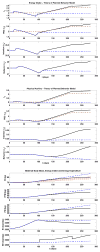A Dynamical Systems Model for Improving Gestational Weight Gain Behavioral Interventions
- PMID: 24309837
- PMCID: PMC3848427
- DOI: 10.1109/acc.2012.6315424
A Dynamical Systems Model for Improving Gestational Weight Gain Behavioral Interventions
Abstract
Excessive gestational weight gain (GWG) represents a major public health concern. In this paper, we present a dynamical systems model that describes how a behavioral intervention can influence weight gain during pregnancy. The model relies on the integration of a mechanistic energy balance with a dynamical behavioral model. The behavioral model incorporates some well-accepted concepts from psychology: the Theory of Planned Behavior (TPB) and the principle of self-regulation which describes how internal processes within the individual can serve to reinforce the positive outcomes of an intervention. A hypothetical case study is presented to illustrate the basic workings of the model and demonstrate how the proper design of the intervention can counteract natural trends towards declines in healthy eating and reduced physical activity during the course of pregnancy. The model can be used by behavioral scientists to evaluate decision rules for adaptive time-varying behavioral interventions, or as the open-loop model for hybrid model predictive control algorithms acting as decision frameworks for such interventions.
Figures






References
-
- Abrams BM, Rasmussen K. GWG and later maternal health: are they related. Am J Clin Nutr. 2011;93:1186–1187. - PubMed
-
- Institute of Medicine National Research Council. Weight gain during pregnancy: reexamining the guidelines. The National Academies Press; Washington, DC: 2009. - PubMed
-
- Asbee SM, Jenkins TR, Butler JR, White J, Elliot M, Rutledge A. Preventing excessive weight gain during pregnancy through dietary and lifestyle counseling: a randomized controlled trial. Obstet Gynecol. 2009;113(2):305–312. - PubMed
Grants and funding
LinkOut - more resources
Full Text Sources
Medical
